They May Have Bombed Saddam And They Didn't Even Know It
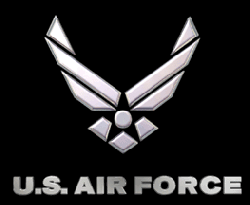 If any combat mission could be called routine,
this was it. USAF Lt. Col. Fred Swan, the Wing Commander, and his
pilot, Capt. Chris Wachter, were flying their B1-B Lancer in search
of targets over western Iraq Monday afternoon when they got a call
from their airborne controller. That's when routine went into the
slipstream.
If any combat mission could be called routine,
this was it. USAF Lt. Col. Fred Swan, the Wing Commander, and his
pilot, Capt. Chris Wachter, were flying their B1-B Lancer in search
of targets over western Iraq Monday afternoon when they got a call
from their airborne controller. That's when routine went into the
slipstream.
"We were actually just coming off the tanker in western Iraq and
we had another target area that we were planned to go - going to,
and we got re-tasked to this target. And in the time frame of 12
minutes from the time we got the coordinates, it took 12 minutes to
get the bombs on target. So that's how quick the system can work,"
said Lt. Col. Swan, speaking from an undisclosed location during a
telephone conference with reporters. Within the span of those 12
minutes, the crew of the B-1 had fed new coordinates into the
weapons systems, changed course and were approaching their new
target. Even then, they didn't know exactly what they were about to
hit.
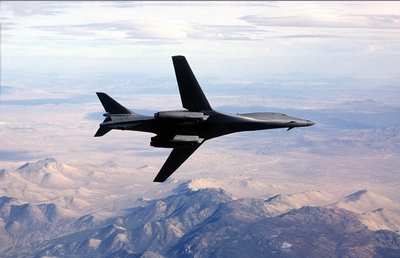
"We were passed a high- priority leadership target," said Capt.
Wachter. "We don't really know who's going to be in there, what
it's going to be. It could be a general. It could be a head of an
intelligence agency. We don't really know. We don't even really
know if it's a bunker or not. We just put the weapons that are
requested for that target. There's targeteers who look at the
building and determine the best weapon to put on the target,
whether it, you know, be something where it's out in the open and
it needs an impact explosion, or we need a bunker- buster that's
going to get some penetration capability to get down underground
before it explodes."
A New Sense Of Urgency
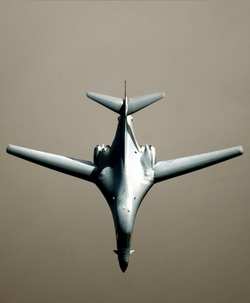 Swan
immediately sensed the urgency of the redirected mission. "When we
got the word that it was a priority leadership target, immediately
or - you know, you get kind of an adrenaline rush, the crew does,
but then you fall back to your original training that says, 'Hey,
let's get the job done.' And we knew we had a - we had to react
quickly to it," Swan said. "So there's four crewmembers on the B-1,
and we all have our own separate jobs to do, but we have to work in
concert, together, to make this happen. So when we get the
coordinates in, in a case like this, the only way to make it work
is have accurate coordinates. So we crosschecked those three
different times with the airborne controller that passed them to
us, and then we checked them again with the jet to make it
happen."
Swan
immediately sensed the urgency of the redirected mission. "When we
got the word that it was a priority leadership target, immediately
or - you know, you get kind of an adrenaline rush, the crew does,
but then you fall back to your original training that says, 'Hey,
let's get the job done.' And we knew we had a - we had to react
quickly to it," Swan said. "So there's four crewmembers on the B-1,
and we all have our own separate jobs to do, but we have to work in
concert, together, to make this happen. So when we get the
coordinates in, in a case like this, the only way to make it work
is have accurate coordinates. So we crosschecked those three
different times with the airborne controller that passed them to
us, and then we checked them again with the jet to make it
happen."
"At the time, for me, what I was thinking was, "Well, you know,
this could be the big one. Let's make sure we get it right."
I had a fairly inexperienced other WSO with me, so I was
basically trying to make sure that he was doing his job right and
that I was doing mine right. We got the coordinates in, assigned
the weapon, turned towards the target area and go. So there wasn't
a lot of time for reflection as we were doing the bomb run. It was
just mainly quarterbacking the crew to make sure that we got the
weapons on the target at the assigned time and to make sure that we
had the coordination that we need to get into that area."
Getting There, Getting The Job Done
What went through Wachter's mind as his Lancer approached the
target?
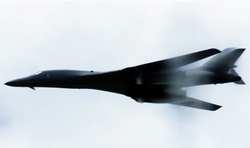 Three
things, he said. "The first part, when we get the target, there's
not a lot of time. They tell us it's a high priority target. And so
basically, it's like you're kind of sitting around waiting for
something and then you get the call, and it becomes go time really
fast. The key there is not what is the target but making sure that
we are 100 percent accurate with the proper weapons they have
requested to put on that target and our coordinates are right. And
then oh, by the way, we're going into a(n) area where we're going
to get shot at, so we want to make sure that we have the ways to
protect ourselves. We do have good systems on board our aircraft,
but also I want to get my package together of my SEAD players,
suppression of enemy air defense assets up there. I want to make
sure that the airborne AWACS knows where I am and where the other
players are and is able to deconflict any other aircraft that may
be in the area. And then, as a final qual check, I want to make
sure that I'm heading in the right area, we have our right systems
on board selected. And a big part of that is just looking out the
window to see if anything's coming back up at me. And so, you don't
really dwell on so much what the target is or who it could be at
the time."
Three
things, he said. "The first part, when we get the target, there's
not a lot of time. They tell us it's a high priority target. And so
basically, it's like you're kind of sitting around waiting for
something and then you get the call, and it becomes go time really
fast. The key there is not what is the target but making sure that
we are 100 percent accurate with the proper weapons they have
requested to put on that target and our coordinates are right. And
then oh, by the way, we're going into a(n) area where we're going
to get shot at, so we want to make sure that we have the ways to
protect ourselves. We do have good systems on board our aircraft,
but also I want to get my package together of my SEAD players,
suppression of enemy air defense assets up there. I want to make
sure that the airborne AWACS knows where I am and where the other
players are and is able to deconflict any other aircraft that may
be in the area. And then, as a final qual check, I want to make
sure that I'm heading in the right area, we have our right systems
on board selected. And a big part of that is just looking out the
window to see if anything's coming back up at me. And so, you don't
really dwell on so much what the target is or who it could be at
the time."
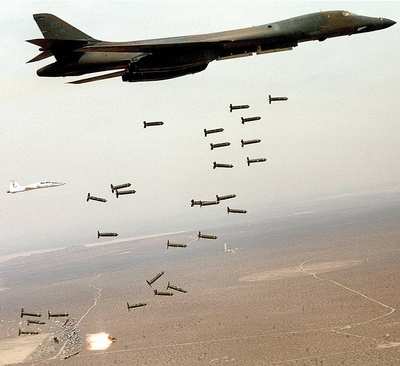
Twelve minutes after the initial assignment, four of the
Lancer's 24 GBU-31 2000 lb. "bunker buster" bombs were in the
air.
"Once you release the weapons, that's a good feeling," said
Wachter. "It's a good feeling to have the bombs come off the jet,
because you know that you're aiding someone somewhere by striking a
target. And so, that's a good feeling and it lasts for about, oh,
three seconds, and then you begin your turn off target and you
egress out of that threat environment and - because you want to
bring your plane back home so your friends in the squadron can fly
it the next day, of course."
Then They Found Out Who May Have Been At The Target Site
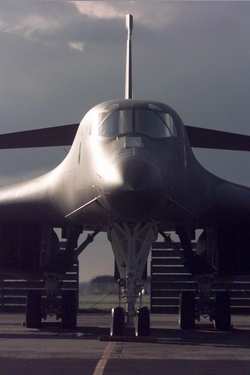 When
Wachter's B1-B finally landed back at base, he, Lt. Col. Swan and
the other two crewmembers on board finally got a sense of what they
may have done. They may have killed Saddam Hussein and one or both
of his sons.
When
Wachter's B1-B finally landed back at base, he, Lt. Col. Swan and
the other two crewmembers on board finally got a sense of what they
may have done. They may have killed Saddam Hussein and one or both
of his sons.
"When you get back and you find out that - you know, you knew
you struck your targets, but then you find out what they are, and
especially something like this, it's a feather in the cap. It's a
good feeling. But I want you guys to know that anyone could do
this. Anyone in my squadron has this ability to go in and do this.
It just so happens we were the lucky ones," said Wachter.
A short time after they returned from the mission, they had a
chance to see satellite television images of the strike damage. "I
think everyone's really proud. That shows a 100 percent surgical
strike properly executed with the proper weapon. And we're all real
proud of that, that we were able to put the bombs on target and
only hit the one target we wanted to hit and do it accurately and
very quickly."
Lt. Col. Fred Swan, Capt. Chris Wachter, Capt. Sloan Hollis and
Lt. Joe Runci are all members of the 405th Air Expeditionary
Wing, based at Ellsworth AFB (ND).
 Aero-News: Quote of the Day (10.23.25)
Aero-News: Quote of the Day (10.23.25) United Airliner Likely Hit Weather Balloon, Not Space Object
United Airliner Likely Hit Weather Balloon, Not Space Object Atlanta Cops Block Attempted Shooting at Hartsfield-Jackson
Atlanta Cops Block Attempted Shooting at Hartsfield-Jackson Aviation Tracking Technology Bill Flies Through the Senate
Aviation Tracking Technology Bill Flies Through the Senate ALPA Praises Bipartisan Bill To Mitigate Helicopter Risks
ALPA Praises Bipartisan Bill To Mitigate Helicopter Risks








